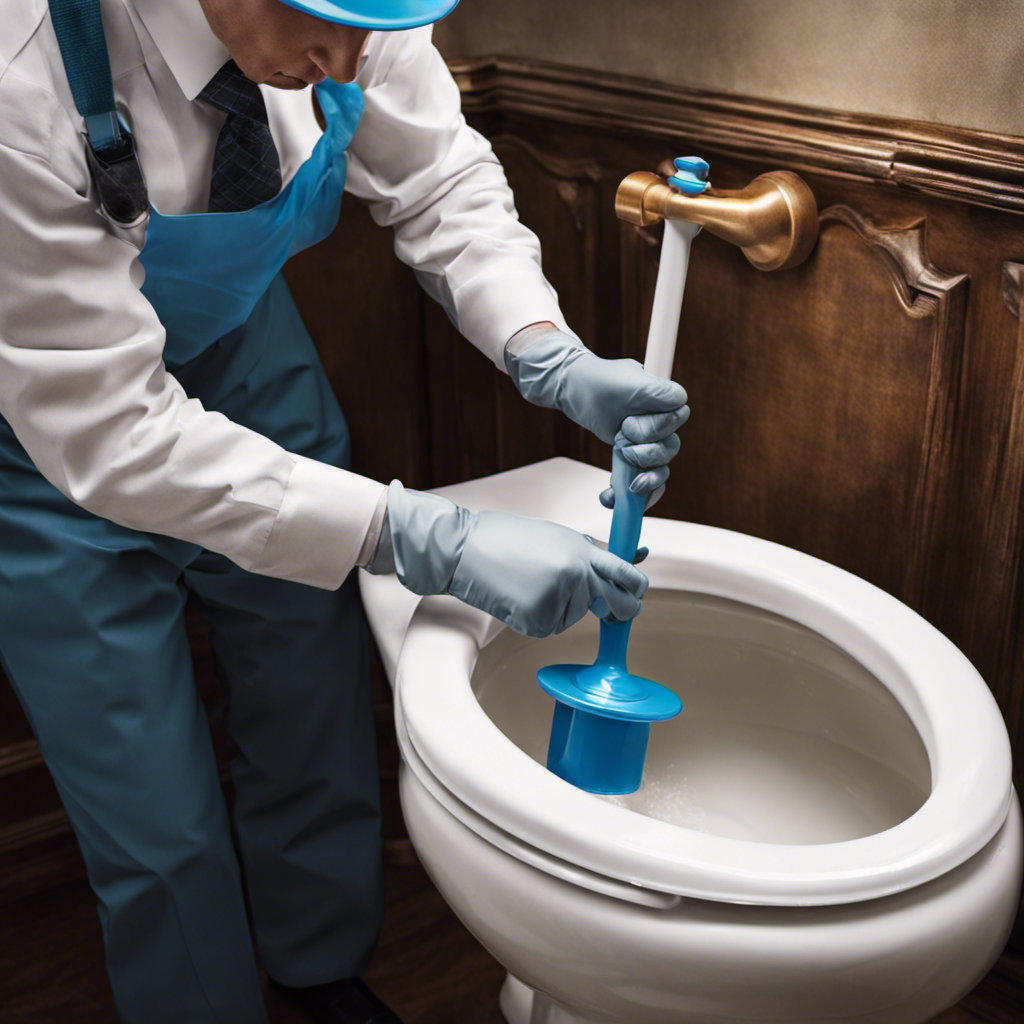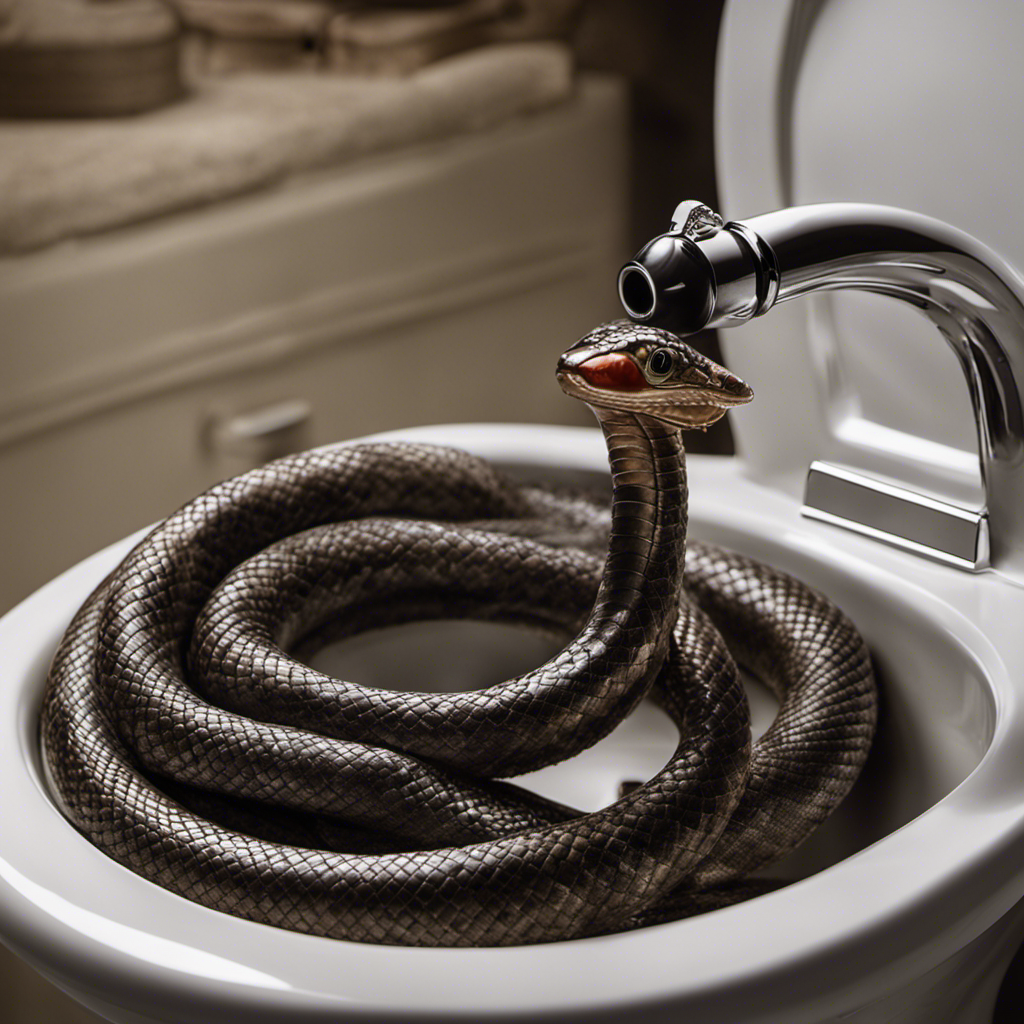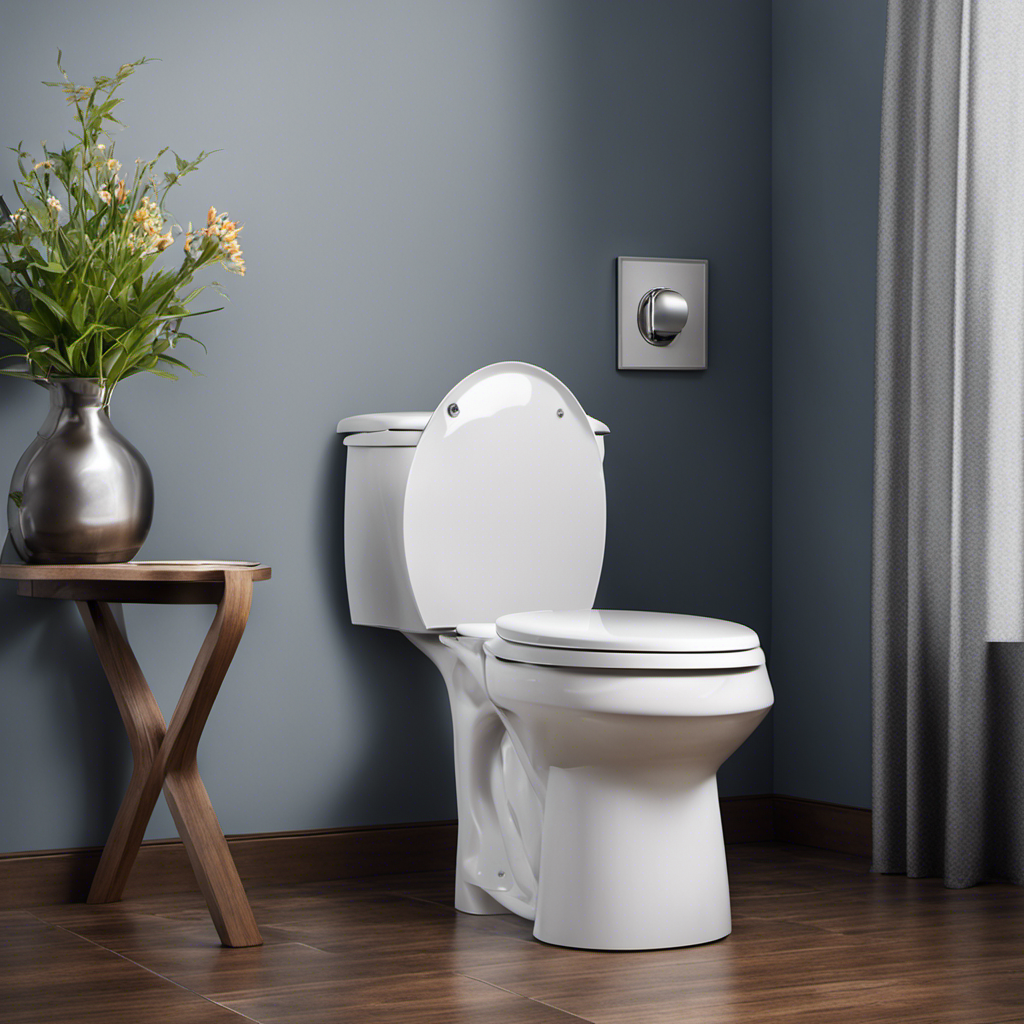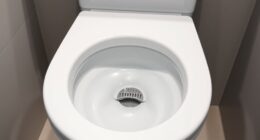I’ve always believed that knowing how to use a plunger properly is an essential skill for any homeowner. When faced with a clogged toilet, there’s no time to waste.
In this article, I will guide you through the process of using a plunger effectively, from understanding the different types to troubleshooting common issues.
Get ready to tackle those stubborn clogs with confidence and keep your toilet running smoothly. Let’s dive in!
Key Takeaways
- Different types of plungers serve specific purposes, such as cup plungers for sinks and tubs, flange plungers for toilets, and accordion plungers for stubborn clogs.
- Choosing the right plunger size and type is crucial for effective plunger use.
- Proper water level in the toilet bowl greatly impacts the effectiveness of plunging.
- Regular plunger maintenance, including inspection and cleaning, is important for longevity and optimal performance.
Understanding the Plunger: Types and Purpose
There are different types of plungers, and each serves a specific purpose. Understanding the different types of plungers is crucial for effective plunger maintenance and ensuring its effectiveness.
The most common type of plunger is the cup plunger, which has a rubber cup that creates a seal around the drain. This type of plunger is ideal for unclogging sinks and tubs.
Another type is the flange plunger, which has an additional piece of rubber that extends from the cup. This design allows for a better seal around the toilet drain, making it the perfect choice for unclogging toilets.
Lastly, there are accordion plungers, which have a bellows-like design that provides extra suction power. These plungers are great for stubborn clogs that require more force.
Preparing Your Plunger and Toilet
When it comes to unclogging a toilet, there are several key factors to consider: the size and type of plunger, the water level in the toilet bowl, and the proper plunger technique.
First, choosing the right plunger size and type is crucial for effective results.
Secondly, ensuring the correct water level in the toilet bowl can greatly impact the effectiveness of the plunging process.
Plunger Size and Type
To find the right plunger for your toilet, you should consider the size and type that will work best for you. Plunger maintenance is important to ensure its effectiveness and longevity. Here is a table comparing different types of plungers and their recommended use:
| Plunger Type | Description | Recommended Use |
|---|---|---|
| Cup Plunger | Standard plunger with a rubber cup at the end | Works well on flat surfaces, like sinks or bathtubs |
| Flange Plunger | Similar to a cup plunger, but with an extended rubber flange | Specifically designed for toilets, creates a better seal around the drain |
| Accordion Plunger | Has a bellows-shaped rubber cup that expands and contracts | Ideal for toilets with irregular or curved drains |
Choosing the right plunger is crucial for effective unclogging. Consider the size and shape of your toilet drain, as well as the type of blockage you’re dealing with. Regular plunger maintenance, such as cleaning and ensuring a tight seal, will prolong its lifespan and keep it in good working condition.
Toilet Water Level
The water level in your toilet bowl can affect its overall performance and functionality. It is important to maintain the correct water level to ensure proper flushing and prevent issues such as clogs and weak toilet water pressure.
To adjust the water level in your toilet, locate the water level adjustment valve. This valve is usually located on the fill valve, which is connected to the water supply line. To increase the water level, turn the adjustment valve clockwise. To decrease the water level, turn it counterclockwise.
Make small adjustments and test the flushing performance after each adjustment to find the optimal water level.
Proper toilet water pressure is essential for effective flushing, so don’t overlook the importance of adjusting the water level in your toilet bowl.
Proper Plunger Technique
You can improve your plunging technique by applying firm, rhythmic pressure and maintaining a tight seal around the drain. This ensures maximum suction and increases the effectiveness of the plunger. However, it’s important to note that proper plunger maintenance is crucial for optimal performance. Many people make common plunging mistakes that can hinder the effectiveness of the tool. Some of these mistakes include not using enough force, not creating a proper seal, and using the wrong type of plunger for the job. To avoid these issues, regularly inspect your plunger for any damage or wear, clean it after each use, and make sure to use a plunger specifically designed for toilets. By following these guidelines, you can confidently tackle any toilet clog and maintain the longevity of your plunger.
| Common Plunging Mistakes | Tips for Proper Plunging |
|---|---|
| Not using enough force | Apply firm, rhythmic pressure |
| Not creating a proper seal | Maintain a tight seal around the drain |
| Using the wrong type of plunger | Use a plunger specifically designed for toilets |
Proper Technique for Plunging
When it comes to plunging a toilet, there are a few key points to keep in mind.
First, it’s important to have the correct hand position on the plunger to ensure a strong and effective plunge.
Second, maintaining a steady and consistent plunging motion is crucial for dislodging any clogs.
Lastly, it’s essential to assess the water level in the toilet bowl before plunging to avoid any messy overflow situations.
Correct Hand Position
To achieve the correct hand position while using a plunger, remember to grip the handle firmly. This will ensure that you have control and power when plunging. Here are some key points to keep in mind for proper grip and effective plunging:
- Hold the handle with your dominant hand and place your other hand on top for added stability.
- Position your hands shoulder-width apart for a balanced grip.
- Maintain a firm grip throughout the plunging process to exert maximum force.
- Keep your wrists straight to prevent strain or injury.
- Apply downward pressure evenly and steadily to create suction and dislodge the clog.
- Make sure to maintain a consistent rhythm while plunging for optimal effectiveness.
- Adjust your grip as needed to maintain control and stability.
Steady, Consistent Plunging
Now that we have established the correct hand position, let’s move on to the next crucial step in using a plunger: steady, consistent plunging.
To effectively clear a clogged toilet, it is essential to employ proper plunging technique. Begin by positioning the plunger over the drain hole, ensuring a tight seal. Apply downward pressure and then pull back forcefully, creating suction and dislodging the blockage. Repeat this motion in a steady and consistent manner, maintaining a good rhythm.
If the water level is too high, you may need to remove some water before plunging. Troubleshooting methods include adjusting the angle of the plunger, checking for any obstructions, and using a different plunger if necessary.
Assess Water Level
Check if the water level is too high by observing the toilet bowl. This step is crucial in assessing the severity of the clog and identifying potential causes. Here are a few tips to help you with this process:
-
Assessing Clog Severity:
-
Look for signs of overflow or slow drainage.
-
Take note of any unusual sounds or odors coming from the toilet.
-
Identifying Potential Causes:
-
Determine if the clog is caused by excessive toilet paper usage.
-
Check if foreign objects, such as toys or sanitary products, have been flushed down the toilet.
Troubleshooting Common Plunging Issues
If you’re having trouble with the plunger, it could be due to a clogged or faulty flapper valve. Troubleshooting techniques can help you identify and fix these common plunging issues.
First, check the flapper valve by removing the lid of the toilet tank and inspecting it for any signs of damage or debris. Clean it thoroughly and make sure it is properly sealing the flush valve.
Another common mistake is using the wrong type of plunger. Make sure you have a toilet plunger with a flange, which creates a better seal.
Additionally, ensure you are using the correct plunging technique by creating a tight seal around the drain and using short, forceful plunges.
By following these troubleshooting techniques and avoiding common mistakes, you can effectively unclog your toilet.
Now let’s move on to the next section about preventing clogs: tips and maintenance.
Preventing Clogs: Tips and Maintenance
To prevent clogs, make sure you regularly maintain your plumbing system by avoiding flushing large amounts of toilet paper or other non-flushable items. It is essential to keep your plumbing system in good working condition to prevent clogs and ensure proper functioning. Here are some tips for preventing clogs and the importance of regular maintenance:
- Regularly clean your drains using a drain cleaner or a mixture of vinegar and baking soda to remove any build-up.
- Use a hair catcher or strainer in your shower or bathtub drain to prevent hair from clogging the pipes.
- Avoid pouring grease, oil, or fats down the drain, as they can solidify and cause blockages.
- Flush your drains with hot water regularly to help remove any accumulated debris.
- Schedule regular plumbing maintenance with a professional to inspect your system and address any potential issues before they become major problems.
Alternative Methods for Unclogging a Toilet
When facing a clogged toilet, you might consider utilizing alternative methods such as a toilet auger or a mixture of hot water and dish soap to help unclog the toilet. These home remedies can be effective in resolving minor clogs without the need for a plunger.
Here is a table outlining two alternative methods for unclogging a toilet:
| Method | Procedure |
|---|---|
| Toilet Auger | Insert the auger into the toilet bowl and rotate it clockwise. |
| Hot Water and Soap | Pour a mixture of hot water and dish soap into the bowl. |
It is important to note that these methods may not work for severe clogs or if there is a larger underlying issue with the plumbing system. In such cases, it is recommended to seek professional assistance.
Transitioning into the next section about safety precautions and cleanup procedures, it is crucial to take certain measures to ensure your safety and maintain cleanliness during the unclogging process.
Safety Precautions and Cleanup Procedures
It’s important to take safety precautions and follow proper cleanup procedures to ensure your well-being and maintain cleanliness throughout the unclogging process. Here are some key steps to keep in mind:
-
Safety Equipment:
-
Wear rubber gloves to protect your hands from bacteria and germs.
-
Consider using safety goggles to shield your eyes from any splashing water or debris.
-
Disposal Methods:
-
Use a garbage bag to dispose of any waste materials or toilet paper that may have been unclogged.
-
Make sure to seal the bag tightly and place it in an appropriate trash bin to prevent odors and contamination.
Frequently Asked Questions
How Do I Choose the Right Type of Plunger for My Toilet?
When choosing the right plunger for your toilet, there are factors to consider. Different plunger types have their pros and cons. It’s important to weigh these factors to ensure effective toilet unclogging.
Can I Use a Plunger on a Clogged Sink or Bathtub Drain?
Using a plunger on a clogged sink or bathtub drain can cause more damage. It’s best to use alternative methods like using a drain snake or a mixture of baking soda and vinegar.
What Should I Do if the Water Level in the Toilet Bowl Is Too High?
When the water level in the toilet bowl is too high, I panic. To prevent overflow, I quickly lower the water level by using a plunger. It’s a simple and effective solution.
Are There Any Risks or Dangers Associated With Using a Plunger?
Using a plunger carries some risks, but with proper precautions, they can be minimized. Make sure to wear gloves, position the plunger correctly, and use gentle force to avoid splashing or damaging the toilet.
How Often Should I Maintain or Replace My Plunger?
Maintaining a plunger is crucial to ensure its effectiveness. Signs of a worn out plunger include cracks, tears, or a deteriorated suction cup. Regularly inspect and replace your plunger when necessary for optimal performance.
Conclusion
In conclusion, I hope this guide has provided you with the necessary knowledge to effectively use a plunger on your toilet.
Remember, prevention is key, so regular maintenance and proper disposal of waste are essential to avoid pesky clogs.
If you do encounter a blockage, don’t panic! With the right technique and a bit of elbow grease, you’ll be able to unclog your toilet in no time.
So, put your best foot forward, roll up your sleeves, and plunge away until your toilet is flowing smoothly once again.
Happy plunging!










